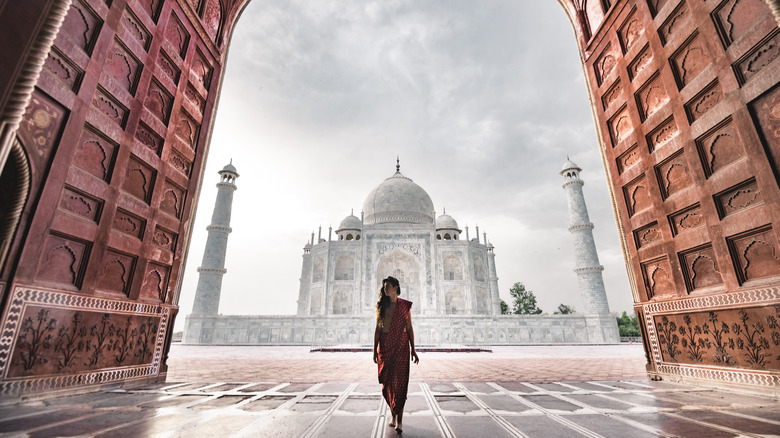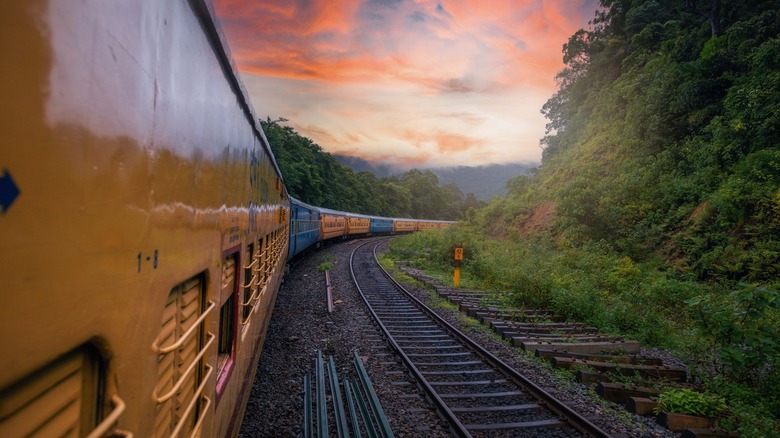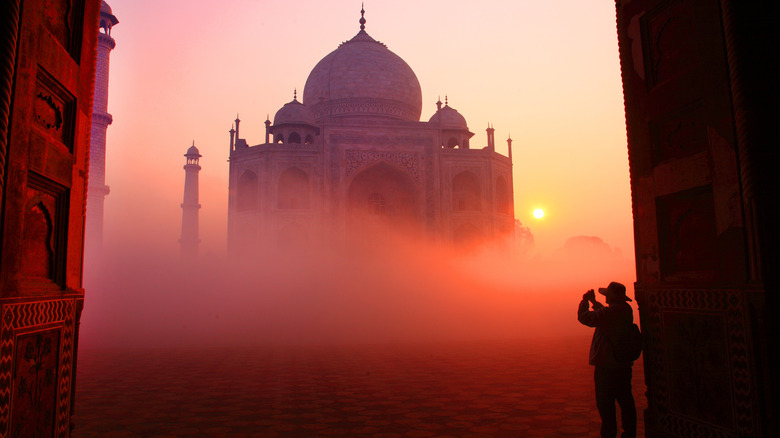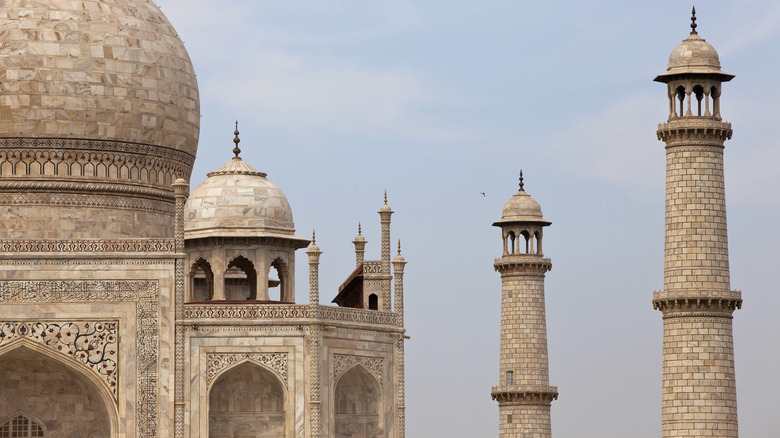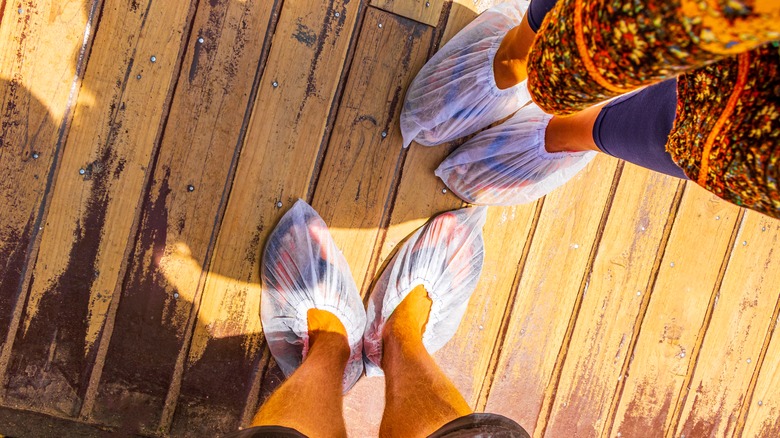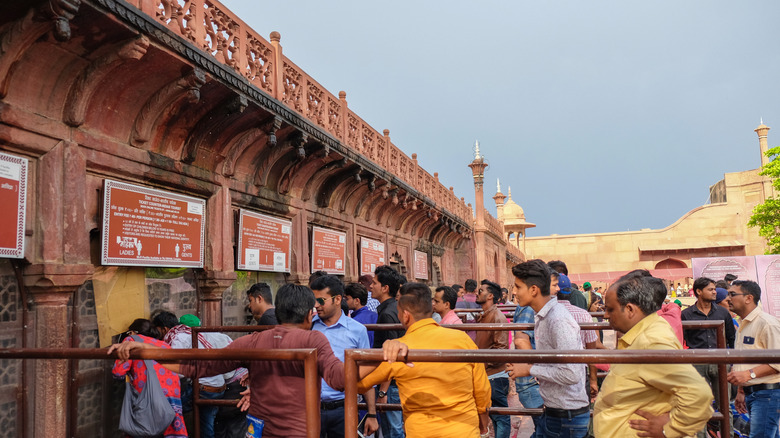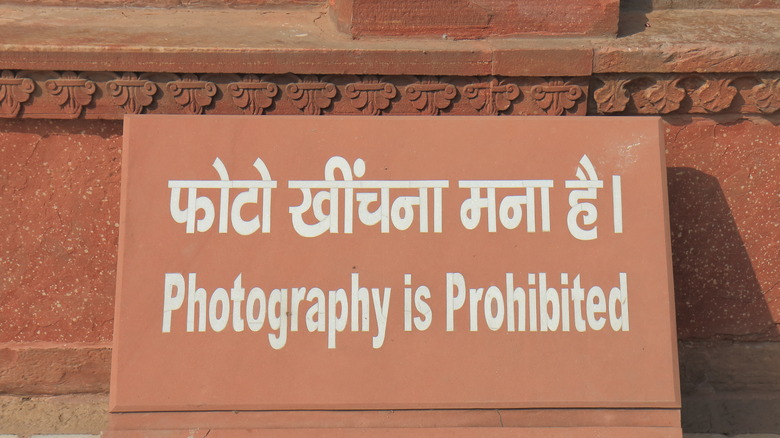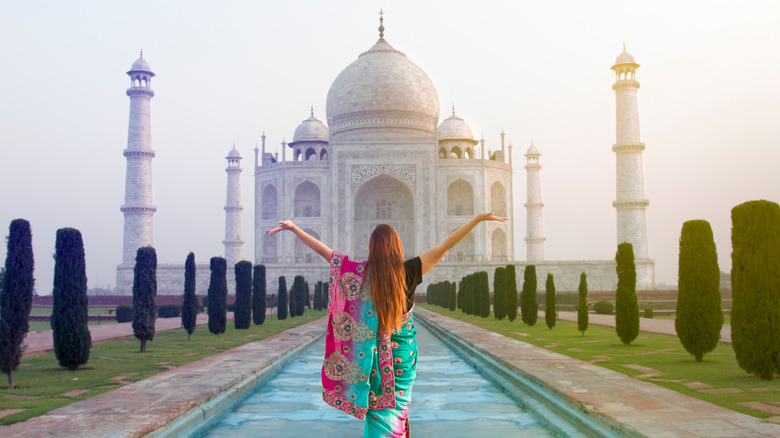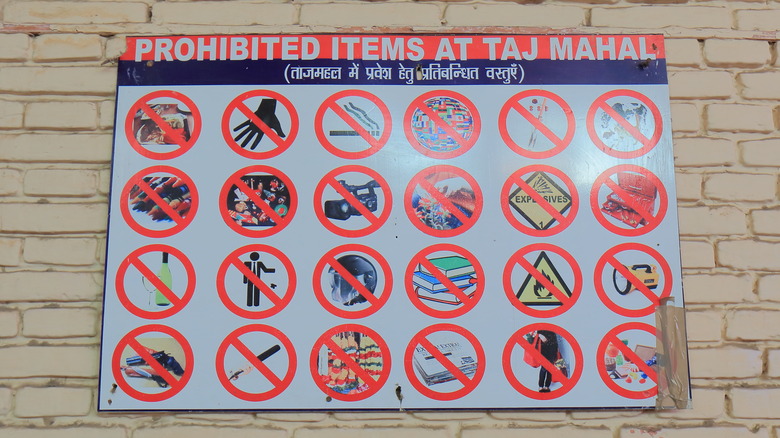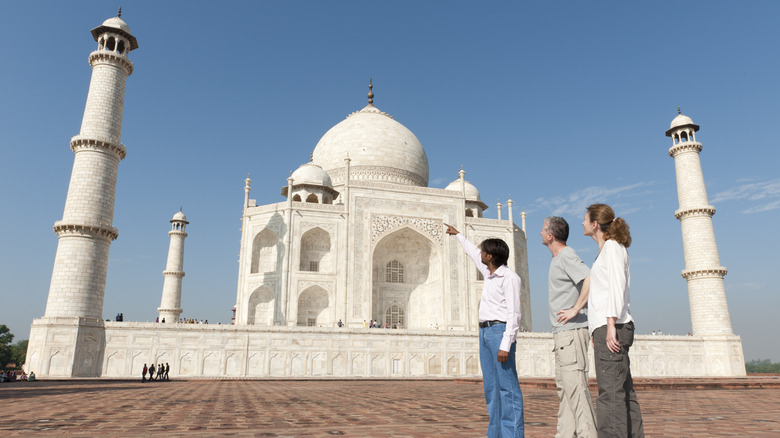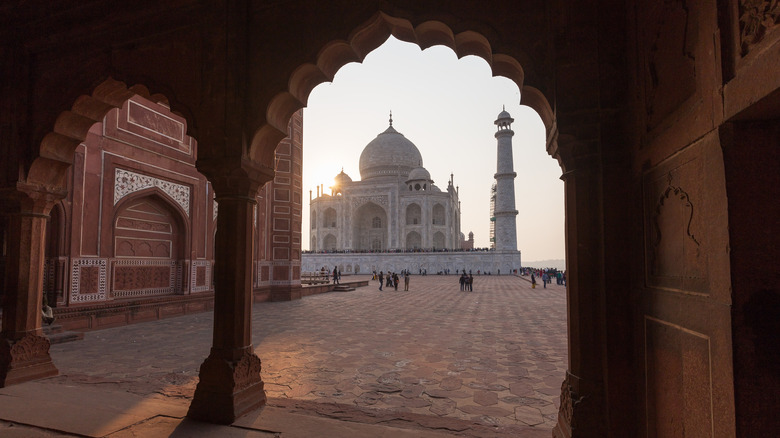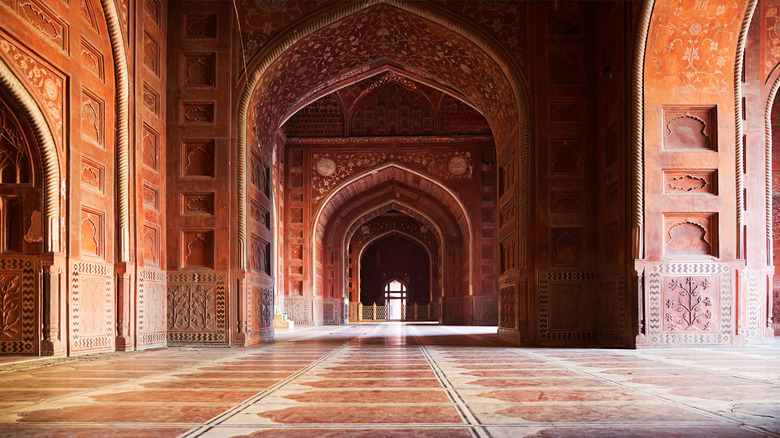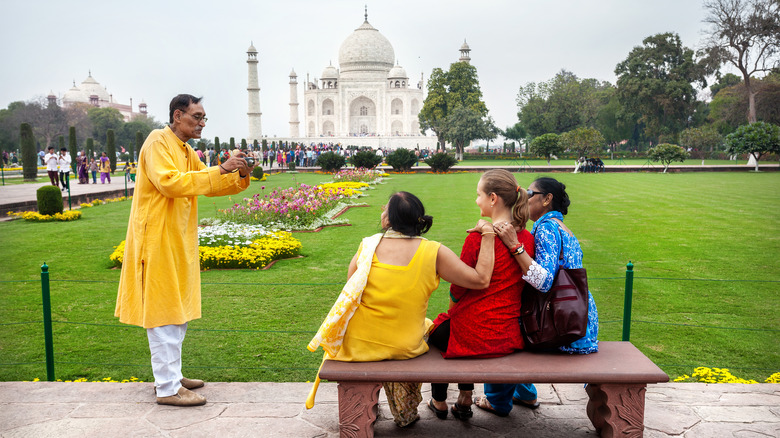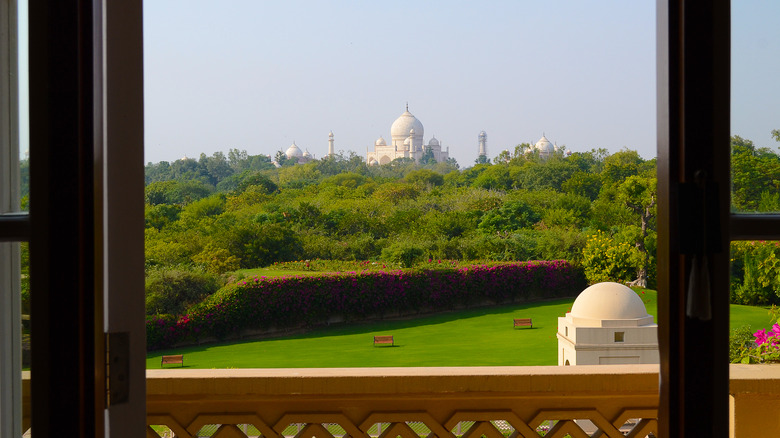13 Things To Know Before Visiting The Taj Mahal
Correction 11/6/23: A previous version of this article stated that the Taj Mahal was north of Delhi. The Taj Mahal is about four hours southeast of the country's capital (Delhi), not north.
When it comes to truly great monuments, it doesn't get much more iconic than the ivory-white marble, and satisfying symmetry, of the Taj Mahal. Perched on the banks of the river Yamuna in Agra, India, countless tourists flock to its gates each year, for an all-important glimpse of what is often heralded as the most beautiful building in the world. Some 20,000 of the most skilled craftsmen from India and Central Asia worked on this ornate masterpiece, featuring thousands of sparkling semi-precious stones, among other delicate materials.
You've probably spotted it in pictures any number of times, but experiencing the allure of the Taj Mahal in person is nothing short of otherworldly. It's a must-see UNESCO World Heritage Site, which it became in 1983, and was even declared the winner of the New7Wonders of the World initiative in 2007. But before you visit in the flesh, it's a good idea to get familiar with everything there is to know about the famous "monument of love". From how much tickets cost and where to snap the best picture, to the ideal time of day to arrive, here's how to make the most of your once-in-a-lifetime trip.
It's pretty convenient to visit
Standing tall and proud in the bustling city of Agra, the Taj Mahal is about four hours southeast of the country's capital, Delhi. Agra is the most populated state in India, which means there are multiple different options for getting here. The fastest route to the Taj Mahal would be to fly. If you're already in India, your best bet is to arrive at Pandit Deen Dayal Upadhyay Airport, in Agra — just over 4 miles from the city center. But if you're coming from outside of the country, the nearest major airport is the Indira Gandhi International Airport in Delhi.
From here, Agra is easy enough to reach by train. You'll want to arrive at Agra Cantt Railway Station, with several superfast, express trains running to and from all the major cities, including Mumbai, Kolkata, and Delhi. If you'd prefer to take the bus, Agra also has a well-developed road network, which you can access from various nearby hubs, including Delhi, Jaipur, and Varanasi. Just make sure you come into the Idgah Bus Stand in Agra — the main bus terminal.
Whichever transport method you choose, you'll need to take a taxi or an auto-rickshaw to reach the Taj Mahal from Agra's center. Be sure to haggle with the driver to avoid paying hefty tourist prices, especially since they won't be able to drop you right outside the Taj Mahal. Vehicles aren't allowed within 500 meters (1640 feet) of the monument because of pollution concerns.
You can't visit on Fridays
From sunrise to sunset, on almost every day of the week, you're free to soak up the Taj Mahal in all its splendor — except on Fridays, when it's closed to allow practicing Muslims to worship. You might want to pass up on a weekend visit, too, just to avoid the huge swathes of crowds at every turn.
Settle on an early-morning strategy, or go for a "last thing at night" visit — the Taj opens 30 minutes before sunrise and closes 30 minutes before sunset. Sunrise is truly magical, thanks to a warm glow descending over its pristine white marble. And with fewer people around, you'll likely have the space and time to fully appreciate all of the monument's intricacies, without distraction. Before sunset is just as rewarding, as the changing colors of the sky create an exquisite backdrop.
There isn't exactly a best time to visit India — each season comes with its pros and cons — but think about your priorities. If you prefer cooler temperatures, visit in the winter, between October and March. Just remember that you'll have to contend with thousands of other tourists with the same idea. Plus, it can get foggy, which may obscure your view. April to May will be hot and humid, but there will be fewer tourists around. That leaves June to September — monsoon season. You may get caught in a downpour, but even fewer visitors are prepared to brave it during this time, and accommodation prices are much cheaper.
It took around 20 years to build
Visiting a historic monument is never quite the same if you don't know the full story, so don't plan this trip of a lifetime without doing your homework first. You'll find that understanding the history gives you a much deeper respect for the Taj Mahal, and allows you to really take in all that this immense structure has to offer.
To give you a little background, the iconic monument we all know and love was commissioned by the fifth Mughal Emperor, Shah Jahan, as a memorial for his third wife, Mumtaz Mahal — she died during childbirth in 1631. The building process was started almost immediately after her tragic death and took around 20 years to complete. As well as incredible white marble from the Indian state of Rajasthan, materials for the Taj Mahal were sought from all over the world, including turquoise from Tibet, white sapphire from Sri Lanka, and jade imported from China. Around 1,000 elephants were also thought to be involved in the construction process, transporting these special materials across borders, and helping to lay them in place.
When the Taj Mahal was finally finished in 1653, there were rumors that the thousands of laborers who helped create it had their thumbs chopped off, so that no such monument could ever be built again! Whether this holds true or not, the Emperor was also buried here after he died in 1666, alongside his beloved wife.
You need to wear shoe covers
A visit to the Taj Mahal can feel a little overwhelming and be a lot to take in. So much so that it may be easy to forget it's also a mausoleum — the final resting place of the Emperor and his true love. It's really important to be respectful of the rules around the monument, including covering your shoes when you go into the burial chamber.
While most temples in India require you to take off your shoes completely, the Taj Mahal simply asks tourists to use shoe covers, which are given to you in a fetching light blue shade, at the ticket booth when you arrive. These are used to prevent dust particles from being tracked into the mausoleum and to keep its marble-clad surfaces as shiny and clean as possible. On your way out of the Taj Mahal, be sure to put these disposable shoe covers, and any rubbish that you have, in the trash cans provided. Sadly, the world-famous monument has suffered from plagues of litter in recent years.
Tickets cost more for international tourists
Don't be surprised to see that domestic tourists pay much less for the privilege of gawking at the Taj Mahal. Indian citizens are charged 50 rupees (approximately $0.70), while foreign visitors must pay 1,100 rupees ($15.50). You'll need to part with even more money if you want to go inside the mausoleum itself — there's an additional 200 rupee fee ($2.50), but it's worth it. Plus, the foreign tourists' ticket comes with shoe covers, a water bottle, a map, as well as a bus or golf cart service, which takes you to the nearest gate. A real lifesaver in Agra's blistering heat. Bear in mind that your ticket is valid for one visit only, but gives you three blissful hours to explore the Taj Mahal.
If you plan to buy your ticket on-site, there are separate counters for domestic and foreign tourists, so be sure to line up accordingly. Both of these booths are likely to be busy with long, snaking queues, which is why it's sensible to arrive as early in the day as you can. In fact, your best bet is to line up at the South Gate and avoid the very busy East Gate at all costs. Or, simply buy your tickets online beforehand.
You should know and respect the rules
As a UNESCO World Heritage Site, every visitor must follow certain rules and regulations inside the Taj Mahal, which have been put in place to protect its magnificence. For example, at no point should you touch the marble, or any other material inside the complex, because it could lead to erosion. As it is, each surface needs special, round-the-clock care to ensure its beauty is preserved for future generations.
Littering and smoking are also not allowed within the Taj Mahal, so make sure you do your bit to dispose of empty water bottles, and other trash, in the bins outside. If your entrance ticket allows you into the mausoleum, remember not to take any photos here and to be as quiet and respectful as you can. This houses the tomb of Emperor Shah Jahan and his wife — for whom thousands of Muslims make the journey each year to pay their respects.
Dress appropriately
You won't find an enforced dress code for the Taj Mahal, but it's always important to be a respectful tourist when visiting India. So, treat the monument like you would any other temple or mosque on your travels. This means keeping your shoulders and everything above your knees covered, as a sign of respect. Sure, you'll notice some foreigners wearing shorts and tank tops, but don't be swept up in this. It's often seen as disrespectful and will only invite unwanted stares.
The best thing to do is play it safe with longer, flowing trousers to keep you covered and cool, as well as kaftans or shawls to hide your shoulders. For guys, wear an overshirt on your top half and a pair of shorts that ideally go down to your knees, or play it safe with full-length pants. If you're feeling exotic, it's possible to rent traditional Indian clothes for your visit, such as a saree or a kurta pajamabut, but expect to pay extra for the privilege.
Leave these things at home
A dress code might not be enforced, per se, but the Taj Mahal has some pretty strict rules about what can be brought into the monument. To save yourself the hassle, avoid carrying a backpack (or anything larger than a small bag), any type of food or drink (even if it's sealed), tobacco products, drones, books, mobile phone chargers, GoPros, headphones, batteries, and tripods. And don't bother trying to sneak any one of these items in, either. The guards at security points really dig through your bag and follow a pretty elaborate frisk procedure for each person.
If you really must have one of these items on you for the day, there are lockers available at the East and West Gates that you can store them in. Having said that, it's much easier just to leave forbidden items at home, so be selective when packing your bag. Bring only your camera and your phone with you, but keep the latter on silent mode in the mausoleum.
Get a guide
For some of the world's most iconic monuments, it could be seen as a waste of money to hire a tour guide. But not the Taj Mahal. Having an expert at your fingertips will really bring the structure to life for you, with stories, and interesting facts you might not hear otherwise. Not to mention be your own personal photographer, and of course, help you with all the best angles for these pictures. There really isn't much information within the complex itself, so it's a bit of a no-brainer. But where do you find the best guide, and how much should it cost?
If you're staying in a hotel nearby, reception staff usually have good contacts with extremely knowledgeable locals. In most cases, they'll be able to offer you a good deal. Or, you could book directly on a local tour guide website, ensuring your hard-earned money goes to a good home. Expect to pay around 2,000 rupees ($25) for a tour guide per day, but if you just want someone to show you around the monument for three hours, you're looking at somewhere near the 1,500 rupee mark ($18). These prices increase dramatically for the pushy kind of guide who lingers outside the Taj Mahal waiting for tourists. So, it goes without saying — book in advance for less stress on the day itself. If you do decide to go with a guide when you arrive, ask them for an approved identity card before you begin.
Where to take the best pictures
The signature shot of the Taj Mahal (the one doing the rounds on social media) is on the approach from the South Gate. You know the one — with a reflection of its world-famous domes in the turquoise fountain, and the majestic white marble of the mausoleum providing the most perfect of backdrops. But it's nearly impossible to get a clear photo here, without other tourists straying into view. So, take your chance and snap away as soon as you arrive — it'll only get busier later on.
If you can't quite get that quintessential shot at this stage, don't be disheartened. There are plenty of other opportunities. What's more, the Taj Mahal is perfectly symmetrical, providing nearly identical views from multiple vantage points. With this in mind, explore the complex as you go and get creative, looking for new angles. One of the most underrated of these is from the mosque on the west side of the mausoleum. It provides the real money shot, and with far fewer people to contend with, too. Who could say no to red-sandstone scalloped archways, providing the most perfect frame for the undisputed star of the show — the mausoleum? Time it for the break of day at sunrise or just before nightfall at sunset, and you're onto a real winner.
Visit the other sites, too
Sure, the main draw of the Taj Mahal is the ivory-white marble of its mausoleum, but there's an entire complex to explore aside from this, so don't miss out. Start with Chowk-i-Jilo Khana forecourt, which houses the main entrance. It's a stunningly beautiful, arched gateway, topped with delicate domes and adorned with floral designs. Next, make your way to the Charbagh, which means four gardens. Prepare yourself for breathtaking views as you walk through Chowk-i-Jilo Khana gateway and into this tranquil space, split into four quadrants by waterways. These gardens are reminiscent of the Koranic description of Paradise — rivers flowing with water, milk, wine, and honey — and a classic sign of the Mughal era.
As you keep moving, you'll come across the aforementioned red-sandstone mosque on the west side, and a perfect replica of it on the east side. This completes the architectural symmetry of the complex and provides a few alternative vantage points for photos. Lastly, if you have time, take in the museum, which is open between 10:30 a.m. and 5 p.m. It's brimming with exquisite miniature paintings, two marble pillars believed to have come from nearby Agra Fort, and portraits of Mughal rulers. This includes those of Emperor Shah Jahan and Mumtaz Mahal, lying in the mausoleum just a few steps away.
Expect photo requests
If you've explored other parts of India, you'll be well-equipped to deal with it by now. But if the Taj Mahal is your first stop in this truly magnificent country, prepare for a multitude of photo requests. This is especially true if you're tall, have pale skin, and fair hair — characteristics that tend to draw a lot of attention. From whole family photos to couples pictures, locals and Indian tourists will likely be very excited to see you in their country, and may even queue up for their chance to take a snap with you.
Unsurprisingly, this can become quite tiring, not to mention take you away from the experience at hand. But 9 times out of 10, these requests come with no malice, so don't be afraid. In fact, it's seen as a gesture of friendship. If this sounds a little strange to you, it may help to understand that many Indians don't have much exposure to fair-skinned foreigners, or may never have traveled outside India before. Having said this, it's perfectly fine to politely refuse, if you're not comfortable. Otherwise, get stuck in and enjoy meeting plenty of friendly and enthusiastic locals.
Where to stay in Agra
It's common for tourists to visit Agra on a day trip from Delhi. But just because it's possible, doesn't mean it's the best use of time. For one thing, it makes visiting the Taj Mahal for sunrise or sunset a tall order — and you don't want to miss that. So, if time allows, try to stay at least one night in Agra to make the most of this very special monument. From budget guesthouses to royal suites with unbeatable views of the Taj, it may be comforting to know that Agra has no shortage of places to lay your head with options to suit every budget.
Taj Ganj is one of the best spots in the city, perched right next to the Taj Mahal itself. In fact, it's the closest area that you can stay to the structure, offering a range of hotels, guesthouses, and hostels. It's also a popular spot for restaurants, with a rich dining hub serving North Indian and Mughlai cuisine. The area is also dotted with craft shops selling carved Taj Mahal replicas, marble inlay work, and semi-precious stones. If you're looking for something fancier, journey just a short distance away to Fatehabad Road. This area is renowned for its upscale hotels and plush, luxury resorts, many of which offer breathtaking views of the monument from deluxe suite rooms and rooftop restaurant terraces.
